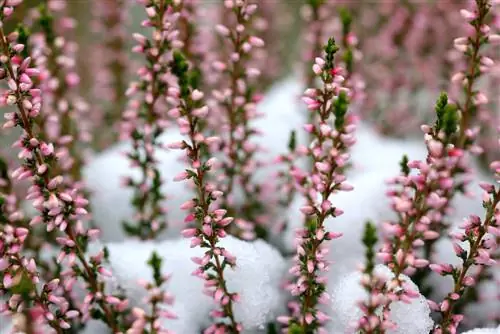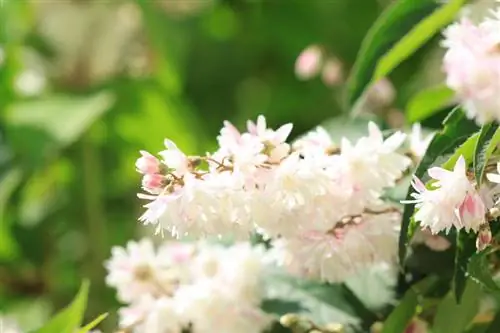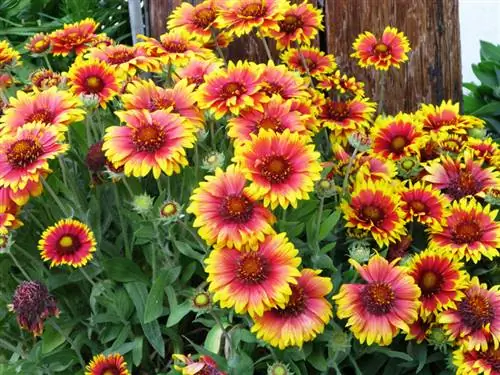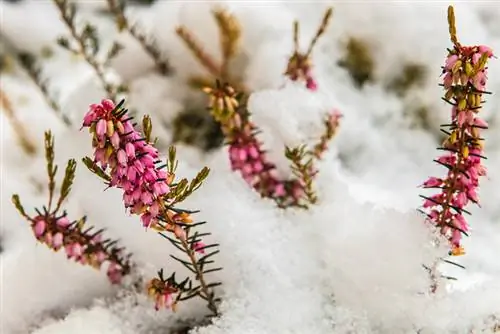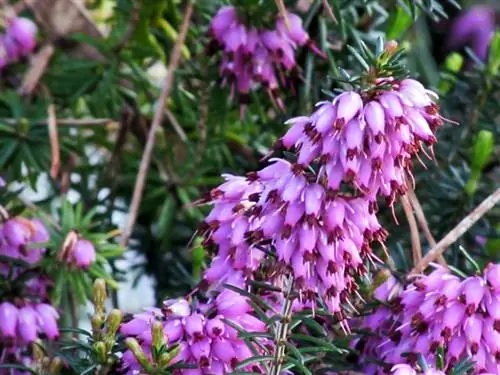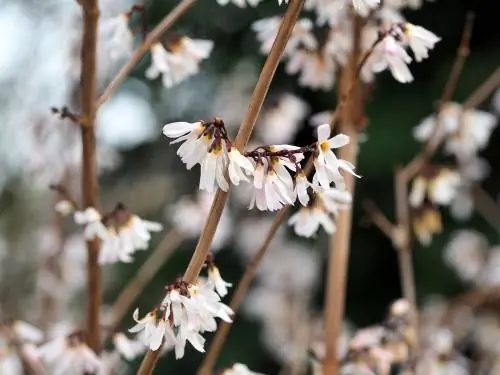- Author admin [email protected].
- Public 2023-12-16 16:46.
- Last modified 2025-01-23 11:21.
Snow heaths live up to their name, as the dwarf shrubs bloom in dreary and gray winter months. Their delicate flowers provide colorful accents on the balcony and in the garden. Although the plant is easy to care for, potted plants in particular require special care.
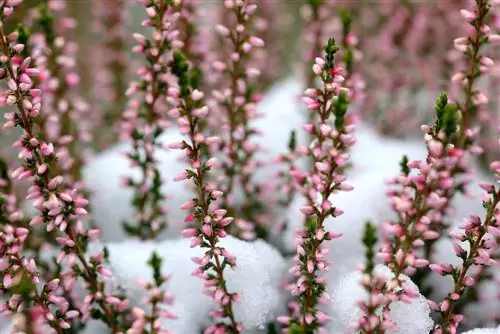
How do you care for the snow heath?
The snow heather (Erica carnea) prefers a sunny location and permeable, fresh, humus-rich soil. It requires moderate water, occasional fertilization and pruning after flowering. Winter hardiness and symbiosis with root fungi are its advantages.
Origin
The snow heather, also known as spring heather or winter heather, belongs to the heather family or Ericaceae. Its botanical name is Erica carnea. The species suffix carnea indicates the color of the flowers. The natural habitat is in mountainous regions of western, central and southern Europe. Snow heaths grow in the Alps up to altitudes of 2,700 meters. They also occur in the flatter foothills of the Alps and in Morocco.
While other species of heather grow on acidic substrates, snow heather prefers areas with limestone soils. Their area is located where dolomite rock shapes the subsoil. The woody plants grow in dry forests with Scots pine, black pine and larches. In the area of the tree line, snow heath dominates the plant community of dwarf shrub heaths.
Growth
As a dwarf shrub, the snow heather develops a low and richly branched bush, the thin shoot axes of which lie low or rise in an arching manner. Their shoots become woody over time. It forms a fine root system that spreads flatly near the top layer of soil. Erica carnea grows up to 30 centimeters high. The snow heather is easily confused with other heather plants. There are subtle differences between the species that make recognition easier:
- Broom heather: leaves opposite and scale-shaped
- Bell heather: leaves ciliate with stiff hairs
- Grey heather: stamens enclosed in the crown
leaves
Snow heaths develop sessile leaves that are arranged in whorls on the shoot axis. The narrow, lanceolate leaf blade merges directly into the shoot axis. It is dark green in color and shiny on the top. A raised white midrib is clearly visible on the underside. The leaves are evergreen and appear needle-shaped due to their reduced shape. These thick leaves are an adaptation to natural locations where important nutrient s alts are missing from the soil.
Bloom
Erica carnea bears nodding flowers that are densely packed together in racemose inflorescences. They sit on one side in the leaf axils and have a hermaphrodite structure. Three dry-skinned and slightly reddish sepals surround a bell-shaped crown, the petals of which are fused. The flowers shine in white, pink and red nuances. What is striking are the dark stamens, which, unlike related heather plants, are not hidden in the crown. They protrude from the crown bell together with the style.
Snow heaths are early bloomers with a flowering period that extends from January to April. Some varieties bloom from December or into May. This makes the plant a valuable plant for bee pastures, because bees and butterflies are responsible for pollination. The dwarf shrubs form their buds the previous year before winter sets in.
Fruit
After the flowering period, each individual flower develops into a capsule fruit. It is hidden deep in the flower bell and opens when it is dry. This special fruit shape ensures that the numerous and very small seeds are dispersed by the wind. These so-called grain fliers are light and can therefore cover long distances.
Usage
Snow heaths are popular ornamental shrubs that decorate not only parks but also gardens. The plants have been bred primarily in England since the early 19th century. Since then, numerous varieties have emerged that differ in their striking flower and leaf colors. Their low growth makes them perfect ground cover plants that are also used as grave plants. Their early flowering makes the dwarf shrubs attractive plants that usher in spring with their splendor of flowers. In large groups, the snow heath unfolds its full effect.
Design options
Erica carnea decorates rock gardens and potted arrangements. It can be placed in mixed beds or planted as a border. The dwarf shrubs harmonize with ornamental grasses, ornamental foliage plants, onion flowers or fine perennials. They look particularly decorative between large stones or gnarled roots.
These are suitable planting partners:
- Broom
- Rhododendron
- Juniper
- small spruces and pines
Snow heaths are popular food plants for special species of moths. The caterpillars of the heather moth and the heather owl, which is classified as endangered, feed on the leaves of the plant. This ecological aspect makes the dwarf shrubs popular plants in naturally designed gardens. The food does not damage the plants.
Edible
Erica carnea does not contain any toxic active ingredients. It is an essential part of herbal medicine and is used in the form of teas and extracts. You can plant the dwarf shrub in your garden without hesitation, even if you have children or pets.
Which location is suitable?
Snow heaths prefer a sunny location. They also thrive in light shade, although the flowers in these places are less lush.
What soil does the plant need?
Permeable soil that meets fresh conditions is ideal for cultivation. Erica carnea likes a humus-rich substrate that can contain lime. It tolerates soils with pH values between 4, 5 and 7. The dwarf shrub forms communities with certain root fungi. This symbiosis is vital so that the plant is supplied with all important nutrients. Therefore, plant newly purchased dwarf shrubs together with the potting soil so as not to destroy the fungus.
You can use these substrate mixtures:
- Rhododendron soil and sand
- Boat soil and perlite
- Peat, sand, garden soil and compost
Propagate snow heather
Erica canea can be propagated using various methods, each of which has its advantages and disadvantages.
Division
Large plant populations are propagated by dividing the root ball. Before you dig up the plant, it should be cut back. The roots are cut into several pieces with a sharp knife so that each part of the plant has enough foliage and buds. When taking this measure, make sure that not too much of the old substrate is lost. It may be that the root fungus has been damaged and the partial plants then no longer grow vigorously or die.
Lowers
In spring you can bend a long shoot towards the ground and score it crosswise at the tip. Lightly cover the part resting on the ground with soil and secure the shoot with a stone. The tip of the branch should protrude from the substrate. Water the substrate regularly and allow the soil to dry between watering sessions.
In autumn you can easily pull the shoot. If it is difficult to remove from the substrate, it has developed enough roots and can be separated from the mother plant. This propagation method has the advantage that the roots of the mother plant are not damaged.
Cuttings
During the growth phase, you can cut shoots from a he althy mother plant. The cuttings should not be completely woody yet so that they can form new roots. Make sure the shoots are between 25 and 35 millimeters long. The lower part is defoliated so that the leaves do not rot. Place the shoot up to the leafy part in a planter filled with potting soil. The soil should be nutrient-poor and constantly moist.
If the pot is high enough, you can cover it with transparent foil. It should not touch the shoot tips, otherwise they will quickly become distorted. This measure promotes constant humidity and the substrate dries out less quickly. It takes about 45 days for the cuttings to develop roots.
Snow heather in a pot
Erica carnea is suitable for container planting. The dwarf shrub cuts a fine figure on balconies and terraces. The container should have drainage holes so that water does not accumulate in the substrate. Overwintering potted plants is difficult. The lower leaves often turn brown after winter. After a while, the dwarf shrub looks unsightly. Appropriate protective measures are necessary to ensure that potted plants survive the winter.
Watering snow heather
Winter heaths have a moderate water requirement. They enjoy occasional watering with rainwater. Stale tap water is also suitable. The substrate should be moderately moist and allowed to dry between watering sessions. The dwarf shrubs also need water during the cold season. Water the plants on frost-free days and, especially with potted plants, make sure that the water drains away completely. Excess water in the coaster should be poured away.
Water the plants only at the base in winter. The water should not run over the leaves, otherwise there is a risk of burns from the sun.
Fertilize snow heather properly
Erica carnea does not need to be fertilized because it obtains all the nutrients it needs through its symbiosis with the root fungus. On poor soils you can support growth by applying a small amount of fertilizer. If the dwarf shrubs show stunted growth or have been recently cut back, they enjoy a weakly concentrated supply of nutrients with a special fertilizer. You can use a liquid rhododendron fertilizer.
Cut snow heather correctly
As soon as the inflorescences have withered, they should be cut back close to the ground. This measure stimulates plant growth and ensures that the dwarf shrubs develop densely bushy branches. Numerous buds form on the fresh shoots in autumn, so that the plants continue to bloom profusely in the next season. Use secateurs with sharp blades that have been thoroughly cleaned beforehand.
If you don't cut the plant back every spring, there is a risk of baldness in the lower area. The snow heather grows deliberately upwards and sheds the lower branches. The longer the shoots become, the more they lean towards the ground. It seems as if the plant is falling apart.
hardy
Winter heaths are extremely frost-resistant and have no problems even with temperatures in the double-digit minus range. The evergreen shrubs need water during the cold season so that their leaves do not dry out. Water the plants on frost-free days.
Overwintering potted plants
If the substrate in the pot freezes, the dwarf shrubs cannot maintain their water balance. The root fungus dies and can no longer supply the plant with nutrients. Waterlogging is also often a problem in winter. If the roots are in cold water, the plants react sensitively. Root rot can occur.
How to protect the bucket:
- spread a thick layer of straw, leaves or brushwood on the substrate
- Wrap pot in jute or cover with straw mats
- Wrap wire mesh around the bucket and fill the gaps with pine branches
read more
Fungal infestation
Honeycomb root rot is an insidious disease that is only noticed late. The spores usually sit in the substrate for a long time without causing any damage. Only waterlogging, frost and drought stress trigger a fungal infestation.
The spores of the fungus Armillaria mellea settle on rotten roots and accelerate root rot. The plant can no longer be supplied with sufficient nutrients and water, so its growth initially stagnates. If the infestation is not noticed, the plant dies. There are no known control measures. Affected plants should be dug up and discarded.
Pests
Snowy heaths are often attacked by the black weevil. The nocturnal beetles are ten millimeters long and lay their eggs at the base of the trunk. The hatched larvae bore into the substrate and feed on the roots. The beetles feed on the leaf mass and leave clearly visible traces of feeding. You should act quickly so that the plant does not die.
Special pest traps have proven to be effective against the beetles. You should check the plant regularly at dusk. When in danger, the beetles drop to the ground and play dead. A decoction of tansy, neem or garlic has a preventative effect against pest infestation. Plant pots can be protected with glue rings.
Administer nematodes of the type Steinernema kraussei to your plant in October and February. They kill the larvae in the substrate. The nematodes require a minimum temperature of 13 degrees Celsius for their metabolism. If your plant is attacked during mild winter months, you should plant it in fresh substrate as a precaution.
Tip
Create a colorful planting arrangement with species that are both hardy and sun-hungry. In addition to snow heaths, horned violets fit perfectly in the balcony box. The silver herb decorates the design with its bizarre growth.
Varieties
- Foxhollow: Wide-growing variety. Leaves golden yellow with an orange tip. Flowering period between February and March, flowers pale pink. Grows up to 30 centimeters high and 45 centimeters wide.
- Springwood White: Stronger growth, prostrate. Tolerates shade. Foliage colored dark green. Flowers large, white with brown stamens. Flowering period between January and May. Grows up to 15 centimeters high and 45 centimeters wide.
- Westwood Yellow: Stocky variety. Leaves golden yellow. Flowers small, dark pink. Blooms between February and March. Growth height and width between 15 and 25 centimeters.
- Vivelii: Dense growth. Leaves dark green, green in winter with a reddish tint. Flowers dark pink with offset corollas, flowering time between March and May. Grows 15 centimeters high and 30 centimeters wide.
- December Red: Spread. Leaves dark green. Flowers small, intense pinkish red. Blooms between December and May. Growth height up to 20 centimeters, width up to 45 centimeters.

